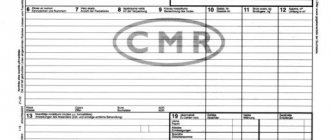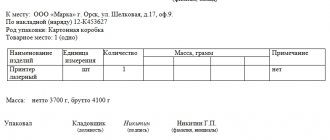A bill of lading is a variant of a standard waybill, used to a greater extent for international transportation of goods by water. Just like the invoice, the bill of lading is the equivalent of a contract for the carriage of goods, which means it includes the entire complex of contractual legal relations between the shipper and the carrier. Files in .DOC: Bill of Lading Form Bill of Lading Sample
Document preparation
A cargo transportation contract in most cases has the characteristics of an adhesion contract, in which the shipper either accepts the contractual terms of the cargo carrier or looks for another carrier.
For this reason, the obligations and rights of the parties under the contract for cargo transportation by sea and river transport are pre-established, and therefore integrated into the standard bill of lading template.
The execution of a bill of lading is preceded by a number of other actions included in the shipping procedure, namely:
- registration of a loading order with information about the goods and the consignee;
- loading and obtaining a navigator's receipt;
- receipt of the bill of lading after the ship leaves the port.
You can read more about the features of the sea transportation contract in the material on our website.
Details and sample
The main details of a bill of lading in accordance with the Merchant Shipping Code of the Russian Federation are: the name of the vessel (if the cargo is accepted for transportation on a specific vessel), the carrier and the sender, the place of acceptance or loading of the cargo, the destination of the cargo (or, if there is a charter, the destination or direction of the vessel), the name of the recipient (nominal bill of lading) or an indication that the bill of lading is issued to the “order of the sender”, or the name of the recipient indicating that the bill of lading is issued to the “order of the recipient” (order bill of lading), or an indication that the bill of lading is issued to bearer (bill of lading to bearer); name of the cargo, the mark on it, number of pieces or quantity and/or measure (weight, volume), weight, freight and other payments due to the carrier, time and place of issue of the bill of lading, number of copies of the bill of lading, signature of the captain or other representative of the carrier.
Since the recipient of the cargo is not always aware of the conditions under which transportation is carried out (for example, when resale of cargo), all important conditions of transportation, such as: general average, limitation of carrier liability, carrier liability, arbitration, applicable law and others are necessarily stipulated in the bill of lading.
Types of Bill of Lading
Depending on the conditions of loading, shipment and method of transportation, the following types of bill of lading are distinguished:
- registered (Bill of lading to a named person), which indicates a specific person entitled to receive the cargo;
- Bill of lading to order, which assumes the possibility of delegating rights to cargo to third parties;
- endorsement, which is essentially a variant of an endorsement;
- to the bearer (Bill of lading to a bearer);
- voyage, that is, involving the transportation of cargo on a voyage ship;
- charter, that is, involving the transportation of cargo on an irregular flight;
- direct, that is, from the place of loading to the destination by one sea vessel;
- coastal (Custody bill of lading), that is, involving the acceptance of cargo by the carrier and its placement in its own warehouse;
- through bill of lading, that is, involving the transportation of cargo using both sea vessels and land transport;
- with reservations, issued by the cargo carrier if cargo with visible signs of damage is accepted for transportation;
- clean, issued by the carrier upon receipt of the cargo for shipment without visible damage.
Functions of a bill of lading
The bill of lading performs several functions simultaneously:
- a receipt from the carrier for receipt of cargo for transportation, with a simultaneous description of the visible condition of the cargo;
- waybill;
- confirmation of the contract for the carriage of goods;
- document of title.
Can serve as collateral for a loan against shipped goods.
Initially, the bill of lading was used when transporting goods by sea. Now a bill of lading can cover transportation not only by sea or river transport, but also those cases when transportation is carried out by different modes of transport. In this case, the bill of lading is called through.
Legislative requirements for the design and content of a bill of lading are set out in the Merchant Shipping Code of the Russian Federation, the Law on the Carriage of Goods by Sea (COGSA: Carriage of goods by sea Act of the USA), several international conventions - for example, the 1924 Convention “On the Unification of Certain Rules on Bill of Lading” (The Hague rules, Haague rules).
What are the consequences of an incorrectly completed bill of lading?
Drawing up a bill of lading is a responsible task. To do this, you need to have specialized knowledge and experience in the field of foreign economic activity. Consequences of incorrectly entering information:
- Financial losses for correcting incorrect information;
- Delay in unloading goods upon arrival at the port of destination;
- Compensation for vessel downtime due to untimely cargo pickup;
- Lengthening the customs clearance process;
- Damage to perishable products, exceeding their shelf life.
Problems can be avoided if you entrust the work to experienced participants in foreign trade activities. The legislator also provided for such a form of correction of inaccurate information as a reservation. It must clearly indicate the inaccuracy, and also contain an explanation of the reason for the corrections and why it was not possible to check the information in advance.
Samples of bills of lading
In this section we have presented for you examples of filling out a bill of lading in Russian and English. You can also download a blank form to create a document to suit the needs of your business.
- Sample in Russian
- Form in English
Contact the customs broker "CONSULT GROUP" - save time and resources. Our foreign trade specialists will fill out the bill of lading and other documents necessary for transporting the goods. You will deliver the goods on time and fully fulfill your obligations to buyers and customers. CONSULT GROUP is your reliable partner for international cargo delivery.
What functions does a bill of lading perform?
1) The bill of lading agreement provides the right to physically delivered goods.
Or, as is sometimes said, the carrier's bill of lading "supersedes" the goods. The legal holder of the bill of lading has the exclusive right to take delivery of the goods. Moreover, a bill of lading is a “negotiable instrument” in that it can be sold or transferred (“put into circulation”), thereby transferring control of the goods. Consequently, the goods can be resold in transit by simple delivery of the bill of lading. 2) The bill of lading evidences the contract of carriage. This international bill of lading must contain the terms of the contract of carriage, either directly or by reference to another document. In a documentary sale, the seller is required to enter into and deliver to the buyer a contract of carriage on “usual” or reasonable terms. In the relationship between the buyer and the carrier, such a necessary contract of carriage will be a bill of lading.
3) A bill of lading is a receipt that confirms delivery of goods to the carrier. It therefore contains a description of the goods and indicates that the goods were loaded on board in a certain quantity and without visible external damage. But, if it is discovered that the goods have been damaged (in one way or another), a special mark is made on the front side of the bill of lading, after which such bill of lading is no longer considered clean.
Consignee (consignee, 2)
This field contains the name and address of the individual or company that has the official right to receive the cargo. When filling out the bill of lading, the specified information is entered in this field. This party may be the owner or ultimate recipient of the goods, but is not always the case. This field can indicate a bank, intermediary or forwarder.
The “Consignee” status on the bill of lading comes with risk and financial liability for possible problems with the cargo. These problems may include the following:
- delay in the release of cargo by customs authorities;
- refusal to release cargo by customs authorities;
- fines and fees for container demurrage at the port or its use after export, etc.
How is a bill of lading regulated?
1) The Hague Rules, officially approved in 1921 (International Convention for the Unification of Rules Concerning Waybills). 2) The Hague-Visby Rules in accordance with the Brussels Protocol of 1968 on the revision of the Hague Rules of 1921. 3) The Hamburg Rules, in accordance with the current UN Convention on Sea/River Transport of 1978. 4) The Merchant Shipping Code of the Russian Federation, officially approved on April 30 1999 Filling out the bill of lading. What should be indicated in the main document 1) Data of the carrier and its exact location; 2) Details of the port of loading of goods according to the cargo transportation contract with the exact date of acceptance of the goods by the transport company at the port of loading; 3) Details of the sender and the exact location of his location; 4) Data of the port of unloading according to the cargo transportation contract; 5) Details of the recipient specified by the sender; 6) The name of the product necessary for its identification with an exact indication of the brand, dangerous characteristics, special properties and weight. In this case, all data must be indicated as specified by the sender; 7) External condition of the product and its packaging; Freight information: size and exact amount to be paid by the recipient;
2) The Hague-Visby Rules in accordance with the Brussels Protocol of 1968 on the revision of the Hague Rules of 1921. 3) The Hamburg Rules, in accordance with the current UN Convention on Sea/River Transport of 1978. 4) The Merchant Shipping Code of the Russian Federation, officially approved on April 30 1999 Filling out the bill of lading. What should be indicated in the main document 1) Data of the carrier and its exact location; 2) Details of the port of loading of goods according to the cargo transportation contract with the exact date of acceptance of the goods by the transport company at the port of loading; 3) Details of the sender and the exact location of his location; 4) Data of the port of unloading according to the cargo transportation contract; 5) Details of the recipient specified by the sender; 6) The name of the product necessary for its identification with an exact indication of the brand, dangerous characteristics, special properties and weight. In this case, all data must be indicated as specified by the sender; 7) External condition of the product and its packaging; Freight information: size and exact amount to be paid by the recipient;
9) Date of issue of the bill of lading; 10) The number of original bills of lading, if there is more than one document; 11) Signature of the carrier or his representative. With the consent of the parties, other data and reservations can be included in the document.
The forms of the bill of lading can be different, because they are developed by various associations, companies and maritime organizations. The most popular bills of lading today are those developed by the following companies: - Genwaybill - a form of bill of lading developed by the Baltic International Maritime Council (BIMCO); — The GGBS Waybill is a form approved by the General Council of British Shipping.
Why do you need a bill of lading?
A bill of lading is, in simple words, a receipt from the carrier that he has received (accepted) the goods and they will be transported.
The receipt also includes a visual assessment of the goods. It serves as evidence of a contract of carriage, proof of ownership, and in some cases, security for a loan.
*click on the picture to open it full size in a new window
If during transportation the conditions for transporting the goods are violated, the owner, recipient, or both at once, will have to go to court to defend their assigned rights.
Contents of a negotiable bill of lading
The negotiable bill of lading contains the following details:
- full name and location of the carrier;
- port (place) of loading and date of loading of the cargo onto the ship (filled in from the sea transportation agreement);
- name and location (address) of the shipper;
- name of the port of destination (from the sea carriage contract);
- information about the recipient - name, location (if the sender is willing and able to enter this data);
- name of the cargo, as well as information necessary for its identification;
- notes indicating that the cargo is dangerous or has specific properties;
- weight of cargo and number of cargo items;
- description of the visible state of the cargo packaging, the goods themselves;
- information about the financial obligations imposed on the recipient, for example, the amount of freight;
- place and time of issue of the bill of lading;
- information on the number of document originals issued, if there is more than one original.
All information about the cargo is entered into the bill of lading in the form in which it is presented by the sender. The document is certified by the signature of the carrier or a person acting on his behalf. The carrier's signature means the signature of the ship's captain. The parties may provide additional information.










